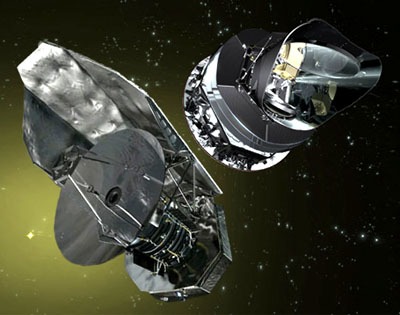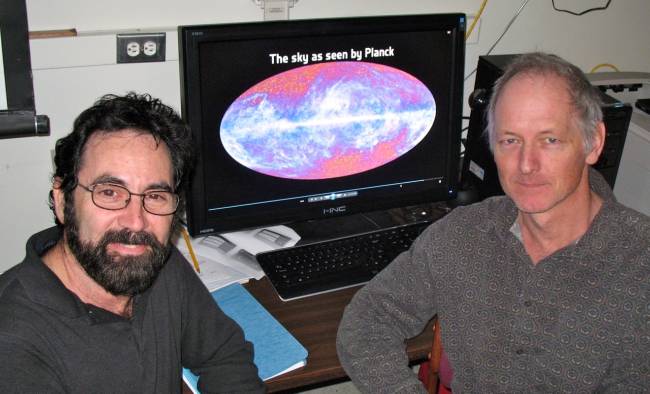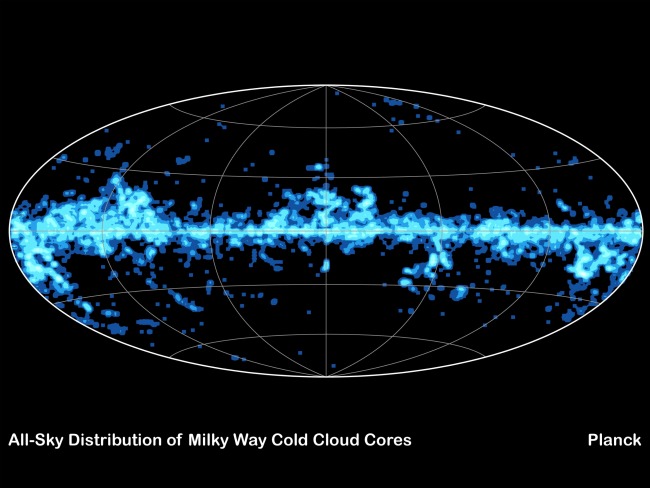Planck Mission Peels Back Layers of the Universe
UCSB Physicists Play Important Scientific Role in International Satellite Mission

Planck – an international satellite that peers back into the beginning of the universe – has produced what scientists are calling new and provocative data. The satellite is a European Space Agency mission with significant contributions from NASA.
On January 11, the Planck mission released a new data catalog with initial maps of the entire sky. The catalog includes thousands of never-before-seen dusty cocoons where stars are forming, and some of the most massive clusters of galaxies ever observed.

“Encoded in the Planck maps is an enormous amount of information, including the birth of our universe and our ultimate fate,” said Philip Lubin, UC Santa Barbara professor of physics and a member of the Planck team. “There is an incredible richness in this data that will help shed light not only on the birth and death of our universe, but on the growth of structure that forms stars and galaxies and that subsequently literally allows life to exist.
“We live in a universe that is extremely difficult for us to comprehend now,” Lubin said. “For example, the existence of dark matter and dark energy that appear to dominate our universe is still beyond our current understanding. The Planck Cosmic Background Radiation data, due to be released in about two years, will help us to more fully study these profound mysteries.”
Jon Morse, NASA’s Astrophysics Division director at the agency’s headquarters in Washington, said that NASA is pleased to support this important mission, and has eagerly awaited Planck’s first discoveries. “We look forward to continued collaboration with ESA and more outstanding science to come,” said Morse.
Planck launched in May 2009 on a mission to detect light from just a few hundred thousand years after the Big Bang, an explosive event at the dawn of the universe approximately 13.7 billion years ago. The spacecraft’s state-of-the-art detectors, some cooled to just 1/10 of a degree above absolute zero, ultimately will survey the whole sky at least four times, measuring the Cosmic Microwave Background, or radiation left over from the Big Bang.

This map illustrates the numerous star-forming clouds, called cold cores, that Planck observed throughout our Milky Way galaxy. Planck, a European Space Agency mission with significant NASA participation, detected around 10,000 of these cores, thousands of which had never been seen before. Cold cores are chilly chambers of gas and dust where stellar embryos are just beginning to take shape. Some of the cold cores found by Planck are the coldest ever observed, as cold as just seven degrees above absolute zero, or minus 447 degrees Fahrenheit.
The data will help scientists decipher clues about the evolution, fate, and fabric of our universe. While these cosmology results won’t be ready for another two years or so, early observations of specific objects in our Milky Way galaxy, as well as more distant galaxies, are being released.
“We’ve been involved in this mission since 1996, nearly the beginning,” said Peter Meinhold, associate research physicist at UCSB and member of the Planck team. “This is the third-generation Cosmic Microwave Background satellite, and it has been very exciting to work on it. Designed to extract the maximum information possible from the Cosmic Background temperature anisotropies, Planck is the culmination of decades of work on the Cosmic Microwave Background radiation.”
Charles Lawrence, the U.S. project scientist for Planck at NASA’s Jet Propulsion Laboratory in Pasadena, Calif., said: “The data we’re releasing now are from what lies between us and the Cosmic Microwave Background. We ultimately will subtract these data out –– to get at our cosmic microwave background signal. But by themselves, these early observations offer up new information about objects in our universe –– both close and far away, and everything in between.”
Planck observes the sky at nine wavelengths of light, ranging from the far-infrared to radio waves. Its technology has greatly improved sensitivity and resolution over its predecessor missions, NASA’s Cosmic Background Explorer and Wilkinson Microwave Anisotropy Probe.
The result is a windfall of data on known and never-before-seen cosmic objects. Planck has catalogued approximately 10,000 star-forming “cold cores,” thousands of which are newly discovered. The cores are dark and dusty nurseries where baby stars are just beginning to take shape. They also are some of the coldest places in the universe. Planck’s new catalog includes some of the coldest cores ever seen, with temperatures as low as 7 degrees above absolute zero, or minus 447 degrees Fahrenheit. In order to see the coldest gas and dust in the Milky Way, Planck’s detectors were chilled to only 0.1 Kelvin.
The new catalog also contains some of the most massive clusters of galaxies known, including a handful of newly discovered ones. The most massive of these holds the equivalent of a million billion suns’ worth of mass, making it one of the most massive galaxy clusters known.
Andrea Zonca, postdoctoral fellow working with Meinhold and Lubin, said: “We are working on the first stage of data analysis of the low frequency instrument –– our starting point is the voltage readout of the instrument and the targets are full-sky maps for frequency channels at 30, 44 and 70 Gigahertz.”
Planck’s new catalog also includes unique data on the pools of hot gas that permeate roughly 14,000 smaller clusters of galaxies –– the best data yet on the cosmic infrared background –– which is made up of light from stars evolving in the early universe. It also includes new observations of extremely energetic galaxies spewing radio jets. The catalog covers about one-and-a-half sky scans.
Jatila van der Veen, visiting project scientist with Lubin’s research group, is the education and public outreach coordinator for the Planck mission. She works in many locations to illustrate the Planck data for the public and is installing exhibits about the Planck mission at the Santa Barbara Museum of Natural History. She also plans a Santa Barbara workshop this summer for teachers in middle school through community college levels.
With funds from JPL, van der Veen directed the development of a simulation of the Planck Mission in 3-D, with graduate students at Purdue University while she was a professor there. This year –– thanks to the generous donation of a large 3-D monitor by Michael Weissman, founder of TrueVision Systems of Santa Barbara –– van der Veen and students at UCSB are installing the Planck Mission simulation in the museum.
She has also organized a touch-screen display, and has put new data in the museum’s Magic Planet Globe. A Planck satellite model will be placed in the museum at the end of January. Last year, also with funds from JPL, van der Veen worked with graduate students of JoAnn Kuchera-Morin, professor of media arts, technology and music, and director of the UCSB AlloSphere, to develop a visual and audio representation of the Cosmic Microwave Background, which she hopes to install in the museum this year.
Planck is a European Space Agency mission, with significant participation from NASA. NASA’s Planck Project Office is based at JPL, which contributed mission-enabling technology for both of Planck’s science instruments. European, Canadian and U.S. Planck scientists will work together to analyze the Planck data. JPL is managed for NASA by the California Institute of Technology in Pasadena.

